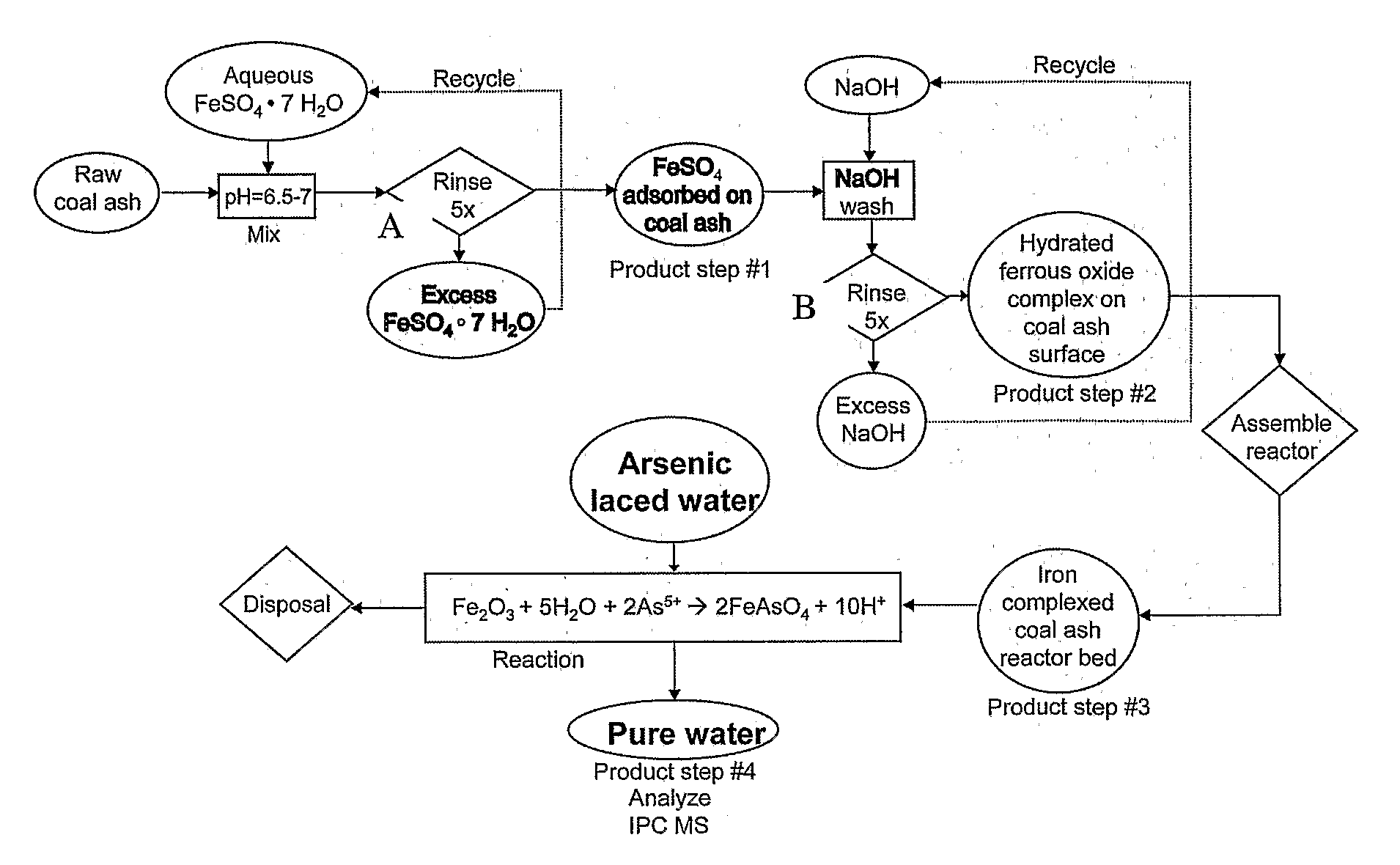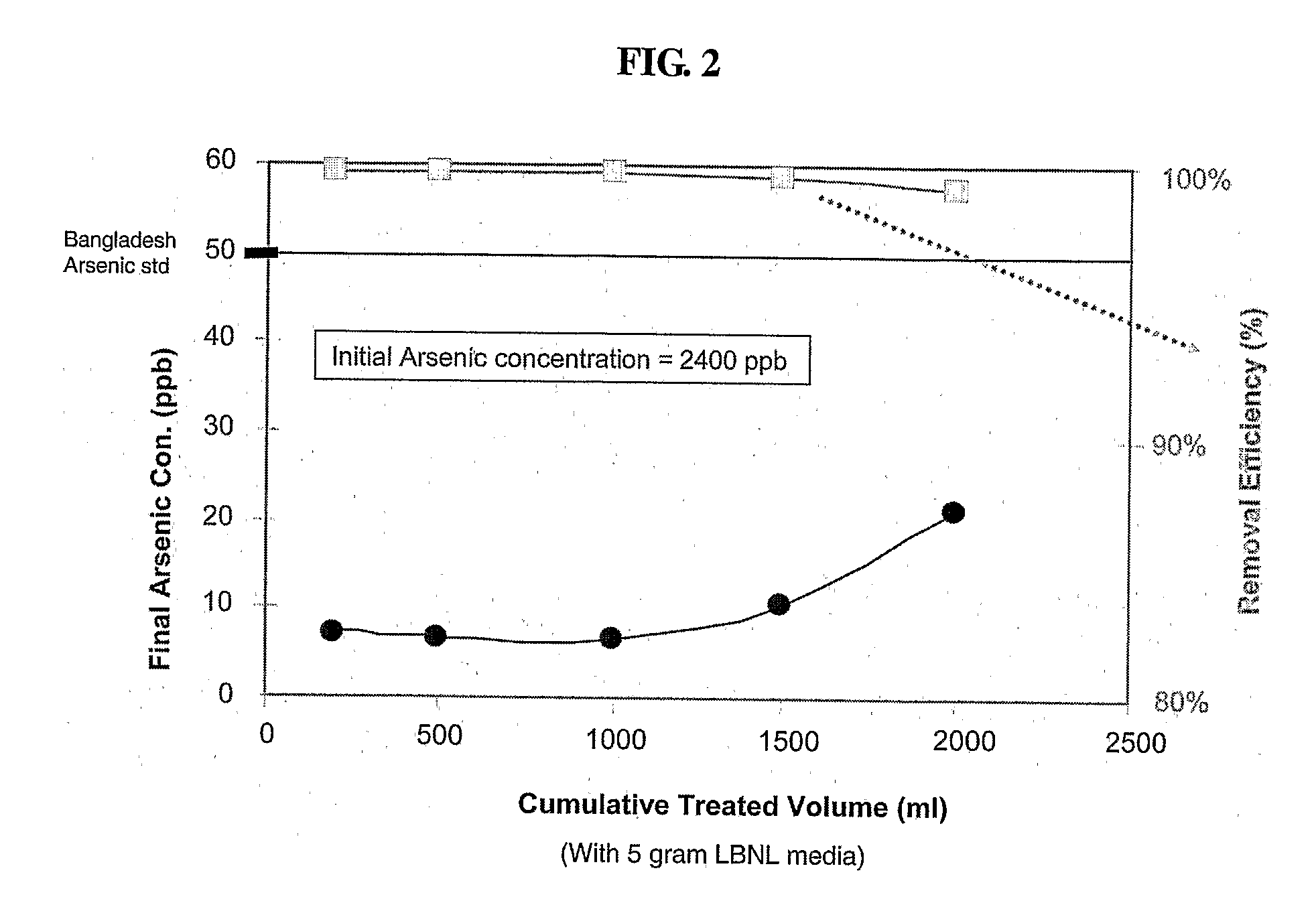Compositions and Methods For Removing Arsenic in Water
- Summary
- Abstract
- Description
- Claims
- Application Information
AI Technical Summary
Benefits of technology
Problems solved by technology
Method used
Image
Examples
example 1
Use of Bottom Ash as an Exemplary Substrate
[0065]In one embodiment, bottom ash from a power plant located in the area in which the water to be treated is located can be used. For instance, South Asian coal fired thermal power plants generate a large quantities of bottom ash suitable for use in the instant invention. This ash is a sterile, finely powdered material with spherical particles consisting mostly of iron, magnesium and aluminum silicates. The particle size range is generally from 1 to 10 microns providing a surface area to volume ratio of about 0.5 m2 per cm3 of the powder. This material is available in the year 2005 for about $4 per ton for disposal from thermal power plants. The instant methods allow the bottom ash to be coated with ferric hydroxide and / or ferric oxyhydride using simple chemistry at room temperatures and avoiding the use of expensive raw materials and high energy expenditures.
[0066]One kg of the media can remove 0.7 gm of elemental arsenic from drinking w...
example 2
Preparation of 5 Grams of Pre-Treated Bottom Ash
[0076]Initially, 5 grams of dry bottom ash are placed in a holding container.
[0077]Approximately 30 ml of 0.6 Molar FeSO4 is mixed with the bottom ash, and continuously stirred for an hour at near room temperature, e.g. 10-40 degrees C. Although this is the room temperature saturation concentration of the FeSO4, lower concentrations could be used for either lower bottom ash surface coverage, or lower quantities of bottom ash. It is possible that FeSO4 concentrations could be usable from the range of 0.1 M or greater.
[0078]After stirring, the solid bottom ash particulate is allowed to settle to the bottom of the holding container for about 5 minutes. At this point, the surface liquid is removed, filtered, and the residue on the filter paper added to the dense mixture at the bottom of the holding container.
[0079]The holding container is then stirred with an aqueous solution of 5 ml of 0.5 N NaOH, and the contents mixed well for 5 minutes...
example 3
[0095]The invention ion also further provides a method for arsenic impurity removal from drinking water, the method comprising: a) collecting bottom ash; b) treating said bottom ash with FeSO4 solution; and c) then treating said bottom ash with NaOH solution. The initial collected bottom ash may be first washed to remove impurities. Also, said bottom ash may have a further step of further washing the bottom ash after treatment with the NaOH solution.
[0096]The treated bottom ash may also be further treated to oxidize said treated bottom ash. The oxidizing step may be performed by air drying, addition of hydrogen peroxide, potassium permanganate (KMnO4), bubbled air, sodium hypophosphite (NaH2PO2.H2O), hydrogen peroxide (H2O2), or other similar oxidizing agent. Additionally, nonoxidizing agents may provide a colorant or color center for absorption of ultraviolet light. Such absorbed photons provide energy for the surface oxidation of the coated bottom ash from an Fe(OH)2 state to an F...
PUM
| Property | Measurement | Unit |
|---|---|---|
| Fraction | aaaaa | aaaaa |
| Fraction | aaaaa | aaaaa |
| Fraction | aaaaa | aaaaa |
Abstract
Description
Claims
Application Information
 Login to View More
Login to View More - R&D
- Intellectual Property
- Life Sciences
- Materials
- Tech Scout
- Unparalleled Data Quality
- Higher Quality Content
- 60% Fewer Hallucinations
Browse by: Latest US Patents, China's latest patents, Technical Efficacy Thesaurus, Application Domain, Technology Topic, Popular Technical Reports.
© 2025 PatSnap. All rights reserved.Legal|Privacy policy|Modern Slavery Act Transparency Statement|Sitemap|About US| Contact US: help@patsnap.com



